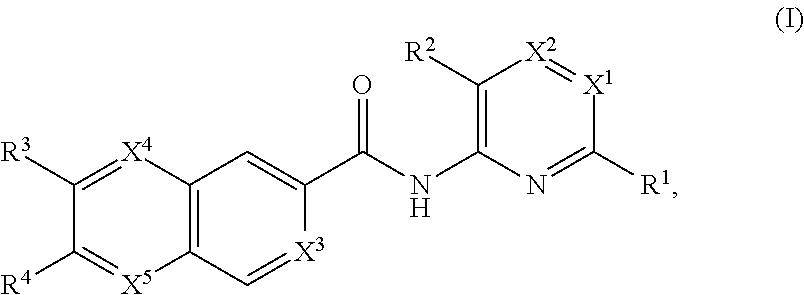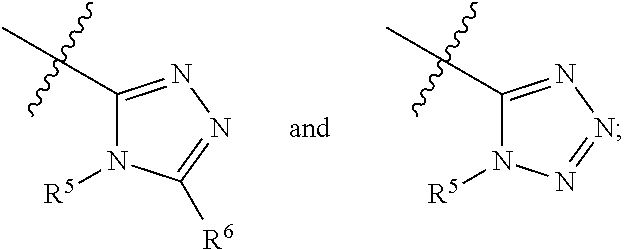Apoptosis signal-regulating kinase 1 inhibitors and methods of use thereof
a signal-regulating kinase and kinase technology, applied in the field of compounds and pharmaceutical compositions useful as ask1 inhibitors, can solve problems such as fat accumulation and fatty acid oxidation, and achieve the effect of prevention or treatmen
- Summary
- Abstract
- Description
- Claims
- Application Information
AI Technical Summary
Benefits of technology
Problems solved by technology
Method used
Image
Examples
example 1
[0285]
[0286]PyAOP (308 mg, 0.59 mmol, 1.2 eq) was added to a suspension of quinoxaline-6-carboxylic acid (94 mg, 0.54 mmol, 1.1 eq) in DCM (2.0 mL). 6-(4-Isopropyl-4H-1,2,4-triazol-3-yl)pyridin-2-amine (100 mg, 0.49 mmol, 1.0 eq) and Et3N (0.16 mL, 1.13 mmol, 2.3 eq) were added and the reaction was stirred overnight. The reaction was partitioned between EtOAc and H2O. The layers were separated and the organic layer was washed with sat. NaHCO3, 10% citric acid, and brine. The organic layer was dried (MgSO4), filtered, and concentrated under reduced pressure. The resultant orange gum was purified by column chromatography eluting with DCM / MeOH (0% MeOH→8% MeOH) to afford Example 1 (23.7 mg, 0.07 mmol, 13%) as a colorless amorphous solid: LCMS (ESI) m / z 360.15 (M+1).
example 3
[0287]
[0288]Methanol (20 μL, 0.487 mmol, 2.5 eq), triphenylphosphine (102 mg, 0.390 mmol, 2.0 eq), and DIAD (76 μL, 0.390 mmol, 2.0 eq) were added to a solution of methyl 3-chloro-7-fluoro-2-oxo-1,2-dihydroquinoxaline-6-carboxylate (50 mg, 0.195 mmol, 1.0 eq), prepared according to US 2012 / 119046, in DCM (mL) and the reaction was stirred overnight. The reaction was quenched with MeOH and concentrated under reduced pressure. The resultant residue was purified by column chromatography eluting with hexanes / EtOAc (0% EtOAc→25% EtOAc) to afford methyl 3-chloro-7-fluoro-2-methoxyquinoxaline-6-carboxylate that still contained some DIAD (42.7 mg) as a yellow solid. This material was used directly in the next step.
[0289]A mixture of methyl 3-chloro-7-fluoro-2-methoxyquinoxaline-6-carboxylate (40 mg, 0.148 mmol, 1.0 eq) and piperidine (44 μL, 0.443 mmol, 3.0 eq) in 1,4-dioxane (0.74 mL) was heated at 90° C. in a microwave reactor for 15 minutes. The reaction was concentrated under reduced pre...
example 8
[0293]
[0294]Methanol (116 μL, 2.87 mmol, 2.5 eq), triphenylphosphine (602 mg, 2.30 mmol, 2.0 eq), and DIAD (447 μL, 2.30 mmol, 2.0 eq) were added to a solution of methyl 3-chloro-2-oxo-1,2-dihydroquinoxaline-6-carboxylate (274 mg, 1.15 mmol, 1.0 eq), prepared according to US 2012 / 094462, in TH (5.7 mL) and the reaction was stirred for 5 hrs. The reaction was quenched with MeOH and concentrated under reduced pressure. The resultant residue was dissolved in DCM and washed with water. The organic layer was dried (Na2SO4), filtered, and concentrated under reduced pressure. The resultant orange gum was purified by column chromatography eluting with hexanes / EtOAc (0% EtOAc→5020% EtOAc) to afford methyl 3-chloro-2-methoxyquinoxaline-6-carboxylate that still contained some DIAD (293 mg, 1.16 mmol, 101%) as a yellow gum. This material was used directly in the next step.
[0295]A mixture of methyl 3-chloro-2-methoxyquinoxaline-6-carboxylate (50 mg, 0.2 mmol, 1.0 eq) and isopropylamine (0.15 mL,...
PUM
| Property | Measurement | Unit |
|---|---|---|
| temperature | aaaaa | aaaaa |
| temperature | aaaaa | aaaaa |
| pharmaceutical composition | aaaaa | aaaaa |
Abstract
Description
Claims
Application Information
 Login to View More
Login to View More - R&D
- Intellectual Property
- Life Sciences
- Materials
- Tech Scout
- Unparalleled Data Quality
- Higher Quality Content
- 60% Fewer Hallucinations
Browse by: Latest US Patents, China's latest patents, Technical Efficacy Thesaurus, Application Domain, Technology Topic, Popular Technical Reports.
© 2025 PatSnap. All rights reserved.Legal|Privacy policy|Modern Slavery Act Transparency Statement|Sitemap|About US| Contact US: help@patsnap.com



